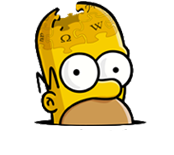
Difference between revisions of "Thank God It's Doomsday/References"
Wikisimpsons - The Simpsons Wiki
(→Trivia: Pasting Charlie Brown into Trivia) |
Snowball II (talk | contribs) |
||
| (13 intermediate revisions by 8 users not shown) | |||
| Line 3: | Line 3: | ||
== Cultural references == | == Cultural references == | ||
| − | *The title is a reference to the popular saying, {{ | + | *The title is a reference to the popular saying, {{W|Thank God It's Friday}}. |
| − | *The song playing when Homer is throwing away his books on the Rapture is {{ | + | *The movie ''[[Left Below]]'' is a parody of ''{{W|Left Behind: The Movie}}''. |
| − | *God's chair is an {{ | + | *The song playing when Homer is throwing away his books on the Rapture is {{W|Three Dog Night}}'s version of "Easy To Be Hard" from the musical ''{{W2|Hair|musical}}''. |
| − | *In heaven, | + | *God's chair is an {{W|Aeron chair}} manufactured by {{W|Herman Miller}}, except that God's chair floats and does not have a base. |
| − | * | + | *In heaven, [[Leonardo da Vinci]] is shown drawing, with his left hand, a portrait of [[Dean Martin]] in the style of the {{W|Mona Lisa}}. |
| − | *The song played as Homer enters heaven is "{{ | + | *Among the changing art pictures displayed above the bed in heaven are: |
| − | *The clock labelled [[Heaven]] is on {{ | + | **A painting of colored rectangles in the style of {{W|Piet Mondrian}}; |
| − | *God tells Homer that his son, [[Jesus Christ]], went down to Earth and he doesn't know what happened to him, but his son hasn't been the same since. This is a reference to the {{ | + | **The classic {{W|Farrah Fawcett}} poster that sold 12 million copies; |
| − | *When God turns back time, he exclaims "{{ | + | **The "{{W|Syndics of the Drapers' Guild}}" painting by {{W|Rembrandt}} (also used in Dutch Masters cigar boxes); |
| − | *In the scene at [[Moe's]] at the end of the episode, Homer and his pals are posed to resemble the {{ | + | **''{{W|Wheat Fields#June – complementary harvest paintings|Haystacks near a Farm in Provence}}'' by [[Vincent van Gogh]]. |
| − | *The skeleton of the crashed [[Duff blimp]], with flames, is a reference to the {{ | + | *The song played as Homer enters heaven is "{{W|The Flower Duet}}" from the opera ''{{W|Lakmé}}'' by {{W|Léo Delibes}}. |
| + | *The clock labelled [[Heaven]] is on {{W|UTC}} or UTC+12 relative to the other clocks labelled [[London]], [[New York]] and [[Tokyo]]. | ||
| + | *God tells Homer that his son, [[Jesus Christ]], went down to Earth and he doesn't know what happened to him, but his son hasn't been the same since. This is a reference to the {{W|Crucifixion of Jesus}}. | ||
| + | *When God turns back time, he exclaims "{{W|Deus ex machina}}", a plot device meaning "God from the machine". It is used ironically since this was the act of the real God to solve an otherwise unsolvable problem, not the god from the mechanical contrivance that ancient Greek dramatists used for the same purpose. | ||
| + | *In the scene at [[Moe's]] at the end of the episode, Homer and his pals are posed to resemble the {{W|Last Supper}} fresco by [[Leonardo da Vinci]], with Homer in the center as [[Jesus]]. | ||
| + | *The skeleton of the crashed [[Duff blimp]], with flames, is a reference to the {{W|Hindenburg Disaster}}. | ||
| + | *[[Moe]]'s sushi bar, "Tokyo Roe's", is a parody of {{W|Tokyo Rose}}, a voice broadcasting Japanese propaganda to Allied soldiers during [[World War II]]. | ||
| + | *[[Krusty]] mentions he doesn't want to die next to [[Kathy Griffin]]. | ||
== Trivia == | == Trivia == | ||
| Line 19: | Line 26: | ||
*[[Homer]] knows the meaning of "eponymous." | *[[Homer]] knows the meaning of "eponymous." | ||
*The cart of wind chimes that [[Bart]] and [[Lisa]] back into at the mall carries the sign, "[[Tinkle in the Wind]]". | *The cart of wind chimes that [[Bart]] and [[Lisa]] back into at the mall carries the sign, "[[Tinkle in the Wind]]". | ||
| + | *Celebrities in the [[Duff blimp]] include: | ||
| + | **{{Ch|Bette Midler}} | ||
| + | **{{Ch|Ron Howard}} | ||
| + | **{{Ch|David Crosby}} | ||
| + | **{{Ch|Joan Rivers}} | ||
| + | **[[Rosie O'Donnell]] | ||
| + | |||
| + | == Continuity == | ||
*[[Charlie Brown]] is shown for the fourth time. The first time he was seen in his ghost costume in "[[Treehouse of Horror II]]", the second time a candle version of him was seen in "[[Grade School Confidential]]" and the third time as a costume in "[[Treehouse of Horror XIV]]". | *[[Charlie Brown]] is shown for the fourth time. The first time he was seen in his ghost costume in "[[Treehouse of Horror II]]", the second time a candle version of him was seen in "[[Grade School Confidential]]" and the third time as a costume in "[[Treehouse of Horror XIV]]". | ||
| Line 25: | Line 40: | ||
[[Category:Cultural references]] | [[Category:Cultural references]] | ||
[[Category:Trivia]] | [[Category:Trivia]] | ||
| + | [[Category:Continuity]] | ||
Latest revision as of 20:22, July 21, 2024
|
|||||||||
|
|
|
Cultural references[edit]
- The title is a reference to the popular saying, Thank God It's Friday.
- The movie Left Below is a parody of Left Behind: The Movie.
- The song playing when Homer is throwing away his books on the Rapture is Three Dog Night's version of "Easy To Be Hard" from the musical Hair.
- God's chair is an Aeron chair manufactured by Herman Miller, except that God's chair floats and does not have a base.
- In heaven, Leonardo da Vinci is shown drawing, with his left hand, a portrait of Dean Martin in the style of the Mona Lisa.
- Among the changing art pictures displayed above the bed in heaven are:
- A painting of colored rectangles in the style of Piet Mondrian;
- The classic Farrah Fawcett poster that sold 12 million copies;
- The "Syndics of the Drapers' Guild" painting by Rembrandt (also used in Dutch Masters cigar boxes);
- Haystacks near a Farm in Provence by Vincent van Gogh.
- The song played as Homer enters heaven is "The Flower Duet" from the opera Lakmé by Léo Delibes.
- The clock labelled Heaven is on UTC or UTC+12 relative to the other clocks labelled London, New York and Tokyo.
- God tells Homer that his son, Jesus Christ, went down to Earth and he doesn't know what happened to him, but his son hasn't been the same since. This is a reference to the Crucifixion of Jesus.
- When God turns back time, he exclaims "Deus ex machina", a plot device meaning "God from the machine". It is used ironically since this was the act of the real God to solve an otherwise unsolvable problem, not the god from the mechanical contrivance that ancient Greek dramatists used for the same purpose.
- In the scene at Moe's at the end of the episode, Homer and his pals are posed to resemble the Last Supper fresco by Leonardo da Vinci, with Homer in the center as Jesus.
- The skeleton of the crashed Duff blimp, with flames, is a reference to the Hindenburg Disaster.
- Moe's sushi bar, "Tokyo Roe's", is a parody of Tokyo Rose, a voice broadcasting Japanese propaganda to Allied soldiers during World War II.
- Krusty mentions he doesn't want to die next to Kathy Griffin.
Trivia[edit]
- God is drawn with 5 fingers on each hand and 5 toes on each foot.
- Homer knows the meaning of "eponymous."
- The cart of wind chimes that Bart and Lisa back into at the mall carries the sign, "Tinkle in the Wind".
- Celebrities in the Duff blimp include:
Continuity[edit]
- Charlie Brown is shown for the fourth time. The first time he was seen in his ghost costume in "Treehouse of Horror II", the second time a candle version of him was seen in "Grade School Confidential" and the third time as a costume in "Treehouse of Horror XIV".
